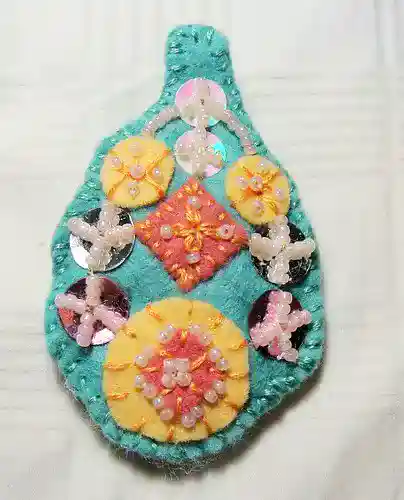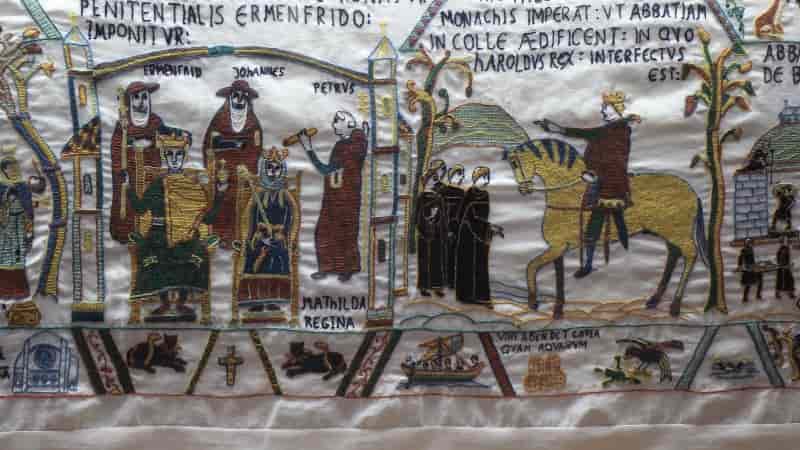Embroidery is the around for centuries, to create a decorative pattern or design on cloth is known as embroidery.
Embroidery dates back to the time of the Cro-Magnons, or around 30,000 B.C. The fossilized remains of clothes, boots, and a cap that had been elaborately hand-stitched and adorned were discovered in a recent archaeological expedition.
Shells were found that had been intricately pierced and then sewn into animal skins for decoration. Thread embroidery in China has been around since 3500 B.C. images depicting garments embroidered with silk thread, gems, and pearls. Chinese chain stitch needlework using silk thread has also been discovered and dated to the Warring States era (5th-3rd century BC). Images prepared by needlework have been found in some of the ancient Egyptian and Chinese tombs. Embroidery art has been found in many ancient civilizations such as Greece, India, and Rome.
As with many other needle and thread arts, the Orient and the Middle East are often credited as the birthplace of embroidery. The first humans immediately realized that the threads they were using to sew animal hides together could also be utilized as decorative accents. Thread embroidery may be seen on sculptures, paintings, and vases showing individuals from a wide range of ancient cultures.
When Was Bead Embroidery Started?

Bead embroidery became popular in the 1200s and 1300s, and tiny seed pearls were used to embellish religious artifacts at this time. By the year 1500 A.D., embroideries everywhere, not only in Europe, were becoming increasingly elaborate and expensive. Elaborate thread and bead embroidery rose to prominence during this time period and persisted throughout the 1700s. Embroidery with beads was commonplace on layette baskets, royal garb, and household wares.
Throughout history, societies as diverse as ancient Persia, India, China, Japan, Byzantium, and medieval and Baroque Europe have used embroidery as a status symbol and a sign of riches. Northern Vietnamese, Mexican, and Eastern European civilizations all share the common practice of passing on age-old, regionally specific-folk arts and crafts from generation to generation. Craftsmanship flourished in medieval England, with the establishment of both workshops and professional guilds. The products of these studios gained notoriety across Europe under the name Opus Anglicanum, which means “English labor.” During the second part of the nineteenth century, the city of St. Gallen in eastern Switzerland became a major center for the production of machine-made embroideries.
Embroidery in the Greeks
In Greek culture, the embroidery was very popular in their civil system. They used the art of embroidery in their garments to show their civil status and occupation. The more embroidery that was used in a garment, the more expensive and of high status it was considered to be.
Embroidery in the Romans
The Romans used to cover their clothing with embroidered images and figures. They also used it to decorate their walls and furniture with flowers, animals, etc. The motifs used in embroideries were such as scenes from everyday life, scenes of animals or human figures engaged in some type of activity, courtly figures, and folklore.
Spread of Samplers
One of the most widely used embroideries in western European countries is the design known as samplers. Samplers were a form of embroidery that involved painting over a small area of an already-finished piece of cloth. Sampling fell out of fashion in the eighteenth century but underwent a revival in the twentieth century and is still popular today.
In the Viking era embroidery was used to decorate clothing and weapons. The Vikings are known to have used the art of embroidery in the unique designs of their clothing and jewelry.
Embroidery in the Middle Ages
In the Middle Ages, the embroidery was mostly done by nuns and was used for church decorations.
The famous story about needlework is the Dream of St. Anskar, a great Viking explorer, which is available in some museums and galleries. Embroidery lessons were given in many schools during the 12th century.
In the middle ages, arts and crafts were neglected. But in the Renaissance era, great progress was achieved in this field. The needlework of that period was known as Lacework or Point lacework.
People learned to make dresses with flower designs, landscapes, and animals beautifully with threads on the cloth. Needlework has become a source of income for many people over the years.
Embroidery in the Victorian Era
In the Victorian era, embroidery became increasingly popular among European aristocrats; this demand resulted in increased production across the globe, especially since many European markets were opened up after the mid-nineteenth century industrialization and urbanization. However, during this time, there was one EU law that had an extremely negative effect on labor within these countries:
It is not uncommon for work to be outsourced abroad to countries with lower wages.
Tailoring, patching, mending, and reinforcing fabric paved the way for the development of sewing techniques, which in turn spawned the art of embroidery due to its ornamental potential. Art needlework and Berlin wool-work emerged with the machine age of the 1800s, signaling the decline of elaborate freehand sewn thread embroidery. Counted cross-stitch of the 1880s, utilizing square meshed canvas with stitch-by-stitch thread patterns, supplanted Berlin wool-work, a type of canvas thread embroidery, as a popular pastime. When color-printed patterns were available, stitch counts were often no longer necessary. Bead embroidery, along with the new needlework techniques of the 1800s, rose to prominence as sophisticated freehand thread embroidery declined.
Traditional Embroidery
Traditional embroidery uses a wide variety of materials and threads, some of which are regionally specific. Fabrics and yarns crafted from wool, linen, and silk date back thousands of years. These days, not just wool, linen, and silk, but also cotton, rayon, and novelty yarns are produced for use as embroidery thread. To embroider flower designs, a slender ribbon made of silk or a silk/organza combination is typically used.
Todays Embroidery Era
Nowadays people decorate their clothes with needlework which is done by hand or with machines to make them look good and attractive. In this way techniques like embroidery and cross-stitch have been introduced in different countries and regions of the world.
Chain stitch and couching or laid-work, two types of surface embroidery, are the most cost-effective ways to employ expensive yarns, and coaching is often reserved for gold work. More yarn is used in canvas work techniques, but the resulting fabric is more solid and durable since the yarn is hidden on the reverse side.
Much modern embroidery is completed on a computerized embroidery machine, with patterns “digitized” utilizing embroidery design software. When it comes to machine embroidery, “fills” are what make the difference in terms of texture and overall aesthetic appeal. Machine embroidery is used to create logos and monograms for company uniforms, presents, and team uniforms, as well as for decorating linens, drapes, and decorator textiles in a style that is reminiscent of the more ornate hand stitching of yesteryear. A popular method of advertising via clothing is the use of embroidered logos on tees and jackets. There has been a significant development in the design, execution, and application of needlework. As its fame increases, it still manages to surprise and captivate audiences.
Final Thoughts
In summary, the art of sewing is still widely practiced today, and that process first started long ago, when humans began to stitch together animal skins for warmth and protection; embellishments soon followed. Ancient Egyptian tombs contain painted scenes showing early forms of needlework; as do Chinese tombs from 20,000 years ago. Since then embroidery has gone through many changes over the centuries, spanning continents and cultures and continuously growing its popularity.

